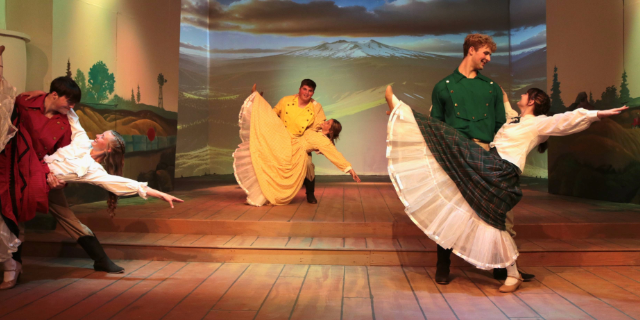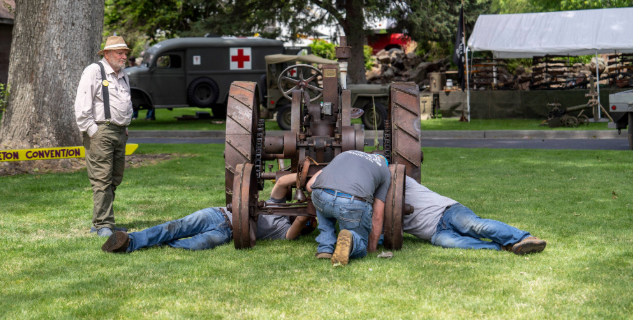Reviving theaters across Eastern Oregon
Published 3:00 am Monday, April 25, 2022

- This photo of a 1950 parade on Main Street in Baker City shows the Orpheum Theatre sign, left of center.
In the early 20th century, small theaters dotted Eastern Oregon to bring vaudeville, musical, and theatric acts to towns both big and small. With the rise of television and cinema, many of those theaters closed down or transformed. Now, four separate theaters are in the process of being brought back.
The Baker Orpheum, Baker City
Of the four projects, the largest capacity theater is in one of the smaller cities. Aletha Bonebrake, chair of the building committee for Eastern Oregon Regional Theatre, said the plan is to restore the 325-seat Orpheum Theater for live performances.
“The goal is to have a high-quality performing arts theater with good acoustics in downtown Baker City,” she said. “We’re moving into the final stage, and we’re so excited.”
The Orpheum building dates back to 1889 and has had different looks over its 133 years as a vaudeville theater, a showplace for silent movies, and a hardware store. Eastern Oregon Regional Theatre took over the building in 2016, and the restoration has another three to four years remaining.
Bonebrake said the restoration is focusing its design to both represent the theater’s heyday and to match with the design of the buildings in downtown Baker City.
“It’s going to be beautiful, and it’s going to transform downtown,” Bonebrake said.
The colors and decor inside are being designed to match a pair of murals discovered in the attic in 2017, shortly after the restoration began. The two murals once stood on either side of the stage and illustrate the Greek musician Orpheus. The original murals contained asbestos, but reproductions will be installed on either side of the stage in the restoration.
The plan calls for a full-size stage, professional acoustics, and specialized lighting. When complete, Bonebrake said they hope to provide space for local artists while also attracting traveling theater.
“We’ve had to tear apart the entire commercial space, eliminate all the hazardous materials and take it down to its shell,” she said. “We are now at that magical point of actual construction, rebuilding an empty shell into a theater space.”
For information, visit eastern-oregonregionaltheatre.com.
The Liberty, La Grande
For decades, few people knew the building next to La Grande’s City Hall had once been a theater.
A music store, the EOU bookstore, and a pizza chain have all called the Liberty home, but for the last 10 years, the facility has moved closer to restoring its past.
Liberty Theatre Foundation Chairman Ashley O’Toole said the Liberty was built in 1910. Then the Arcade Theater, it was a vaudeville-only theater for decades until a major renovation in the 1930s added a cinema system, increased the seating and renamed it. When the Liberty closed in 1959, it was converted into commercial space with the theater — even its chandelier — hidden behind new walls and a drop ceiling.
“There was a huge false ceiling from front to back that completely cut off the rest of the theater from this commercial building. You’d walk into Domino’s and just have no idea that you were in a historic theater because eight feet above your head was a regular commercial celling,” O’Toole said. “You had no idea that above it was a chandelier that was 100 years old. All of that was sealed off from public access from 1959.”
The chandelier was re-lit in January of this year for the first time since 1959.
O’Toole said the goal for the Liberty is to bring it back to its era of “historical significance,” somewhere in the 1930-40s. The theater will include capability for live music, theater and cinema screenings.
“When this thing was turned from a theater to a commercial space, there was a lot of demolition that took place. All the walls and bathroom and stairwells was just gone, destroyed forever,” O’Toole said. “We are at a point now where we are just about done framing all of that back in. That includes the auditorium floor.”
In addition to restoring the look of the classic theater, the project will install modern amenities, including an ADA bathroom and seating, and a larger lobby.
The current timeline for completion of the Liberty depends on funding. O’Toole said costs of materials has delayed the project and they are back in fundraising mode. The goal is to raise $250,000 by July 1 in order to have the theater partially open in time for the Eastern Oregon Film Festival this fall. For information, visit libertyonadams.org.
The Gem Theatre, Athena
Now solidly in its renovation, the Gem Theatre in Athena has housed a saloon, restaurant, dry goods store, and, in 1909, The Dime Theater, a “moving picture house.” The Gem Theatre opened under that name in 1938 with art deco seating on the main floor, an enlarged stage, and even a “cry room” for mothers and small children. The Gem Theatre operated until 1968.
In 2004, the building was donated to the city of Athena to be renovated as a regional theater and performing arts facility. Because of the building’s unusual history, the restoration on the Gem Theatre includes not only the theater spaces (including balcony, cry room, stage, and 308 seats from 1906 to 1938) but also the former Star Saloon that will serve as the foyer and concession area for the theater.
Current renovation projects including installing a historic mahogany front bar in Star Saloon and installing drywall. For information, visit gemtheatre.org.
The Rivoli, Pendleton
On Pendleton’s Main Street, the Rivoli’s marquee was once one of the most recognizable features in downtown Pendleton. Rivoli Coalition President Andrew Picken hopes it will be again.
The Rivoli Theater opened in 1921 and offered movies, vaudeville shows and small theater productions for most of the 20th century. Picken said the theater closed its doors in the mid-1980s after a series of unfortunate remodels and renovations and then sat vacant for the next two decades.
In 2011, the Rivoli Coalition began the long process of planning and re-creating the theater. Studies, designs, and demolition have already taken place, and the project was recently awarded $1.5 million from the Oregon Legislature to help it move forward with the coalition’s goals of creating a community space.
Unlike many of the theater projects, the Rivoli plan calls for a multi-use theater with a flat floor seating area. Picken said that arrangement allows for movable theater seating but also tables and chairs. When open, the Rivoli could be a venue for dinner theater and dances.
“If we build a perfect building but no one comes, we have utterly failed,” he said. “I think it’s very important for communities to have gathering places that are welcoming and sort of consistently comfortable for people across race, religion, socioeconomic status. If we can continue to develop a place like that in Pendleton that is also economically sustainable and good for the community, then I will feel like we have succeeded.”
For updates, visit rivoli-theater.com.





